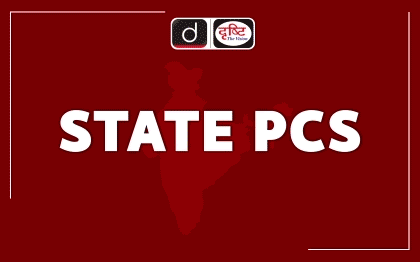Uttar Pradesh Switch to Hindi
Increased Solar Energy Production in Uttar Pradesh
Why in News?
Recently the Uttar Pradesh government announced that solar power generation in the state has increased 10 times in the last 8 years.
Key Points
- About the issue:
- The Uttar Pradesh New and Renewable Energy Development Agency (UPNEDA) shared this information to mark the completion of eight years of the current government.
- The total installed capacity of solar power in the state was 288 MW in the year 2017 , which is expected to increase to 2653 MW in 2025 .
- Efforts of Uttar Pradesh in the field of solar energy:
- Solar Energy Policy – 2022 :
- Target to produce 22 thousand MW of solar energy in 5 years.
- This policy has been made with the aim of reducing dependence on fossil fuels in future.
- Solar Power Park in Bundelkhand :
- A solar park of 4,000 MW capacity is being developed in the Bundelkhand region.
- Development of 800 MW solar projects in Chitrakoot, Banda and other areas.
- Rooftop and Floating Solar Plants :
- 508 MW solar rooftop projects have been installed on the rooftops of houses.
- Solar Energy Policy – 2022 :
- Under this scheme, subsidies are being provided to the people of the state by the Uttar Pradesh government and the central government.
- Uttar Pradesh ranks third in solar rooftop installations after Gujarat and Maharashtra.
- The state's first floating solar plant has been installed in Dibiyapur of Auraiya and a floating solar plant of 1 GW capacity is being installed in Lalitpur.
Solar Energy
- Solar energy, known as energy obtained from the sun, is a clean and renewable energy source. It is harnessed through solar technology, which is mainly of two types:
- Solar Thermal : In this the heat of the sun is used to heat water.
- Solar Photovoltaic (PV) : It uses the photovoltaic effect to convert the sun's rays into electrical energy.
- Use of solar energy:
- Solar technologies are scalable and flexible, capable of powering entire cities through solar farms.
- Electricity can be supplied even to remote areas through decentralized systems.
- Homes and commercial buildings can be provided with energy by installing solar panels on rooftops.
- Example : Cochin International Airport is one such example where solar energy is being used effectively.
- Importance:
- Reduction in dependence on fossil fuels .
- Reducing carbon emissions .
- Improvement in air quality .
- Promote energy access and security .
Uttar Pradesh New and Renewable Energy Development Agency
- The Uttar Pradesh Government established the Alternative Energy Development Institute in April 1983, functioning as an autonomous body.
- Later the name of this organization was changed to Uttar Pradesh New and Renewable Energy Development Agency (UPNEDA) .
- This agency also acts as the state nodal agency for the implementation of various schemes in the state


Uttar Pradesh Switch to Hindi
Agrivoltaic Project
Why in News?
Uttar Pradesh has become the first state in India to adopt an 'Agrivoltaic' project .
Key Points
- Agrivoltaic System:
- Agrivoltaic systems, also known as agri-voltaic systems or "solar-farming", are a new technology that allows farmers to produce electricity while growing their crops.
- In this system, solar panels are installed on agricultural land using photo-voltaic (PV) technology .
- This technology was first introduced by Adolf Goetzberger and Armin Zastrow in 1981.
- Its prototype was developed in Japan in 2004 and after several trials, it was implemented in East Africa in 2022.
- Presently it is being used successfully in countries like India, America, France, Britain and Germany.
- However, this technology is still in its initial stages in India.
- Benefit:
- Addressing the problems of growing energy demand and food security.
- Solar panels reduce evaporation from crops and improve water utilization.
- Solar panels protect crops from high temperatures and UV rays .
- Solar energy reduces the cost of electricity and increases the income of farmers.
- Rain water collected by solar panels and used for irrigation.
- Challenges:
- It is a land-based system, requiring about two hectares of land per megawatt generated.
- During the rainy season when the sky is cloudy, this system is not as effective, and farmers have to rely on alternative energy sources.
- The shade produced by solar panels can sometimes cause plant pests, requiring attention to crops.
- Funding from ADB:
- The Department of Economic Affairs, Ministry of Finance has approved the technical assistance proposal of the State Government titled “Demonstration of Agrivoltaic Projects in Uttar Pradesh”.
- Under this, technical assistance of USD 0.50 million (about Rs 4.15 crore) has been approved from the Asian Development Bank ( ADB) .
- Uttar Pradesh has become the first state in the country to receive this type of financial assistance from ADB.
- Importance:
- Under this project, solar energy is also produced along with agricultural production on the same land.
- This will provide additional income to farmers, increase energy production and promote sustainable development .
- This initiative is an important step towards clean energy production, environmental protection and Sustainable Development Goals (SDGs) .
Asian Development Bank
- Introduction: ADB is a regional development bank established in 1966 with the objective of promoting social and economic development in Asia and the Pacific region.
- ADB assists its members and partners by providing loans, technical assistance, grants, and equity investments to promote social and economic development .
- Headquarters: Manila, Philippines
- Members: It currently has 68 members, of which 49 are from within the Asia and Pacific region and 19 from other regions.
- ADB and India: India is a founding member of ADB and the bank's fourth largest shareholder .
- Supports India's priorities for strong, climate resilient, and inclusive growth, in line with ADB's Strategy 2030 and the Country Partnership Strategy 2023-2027 .








%20MPPCS%202025%20Desktop%20E.jpg)
%20MPPCS%202025%20Mobile%20E%20(1).jpg)










.png)
.png)











 PCS Parikshan
PCS Parikshan


-min.jpg)